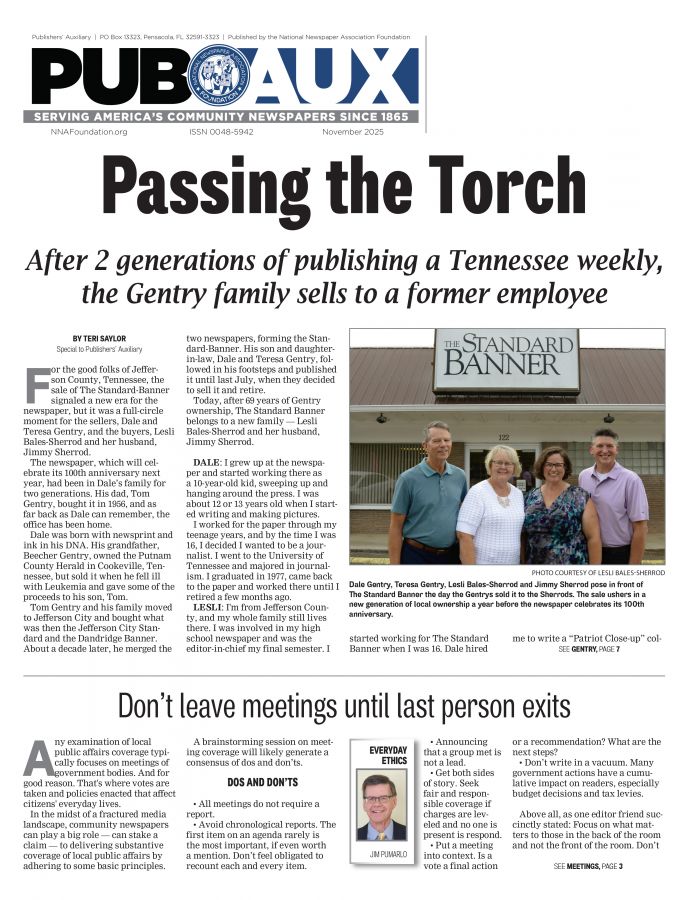Don’t underestimate the value of communicating with readers
Jim Pumarlo
Jul 1, 2025


Today’s hyperpartisan political climate has put all media — including the community press — in everyone’s crosshairs. The examination extends beyond opinion pages, which always have drawn extra scrutiny.
Readers increasingly question the five Ws and H of reporting: Who is the source for a story? What is reported, and what is omitted? Where does the story appear — front page or inside? When does the paper choose to pursue a story? Why is or isn’t something reported? How is the story told?
It’s no surprise that reporters face a growing challenge to get sources — especially government employees, undocumented individuals and others in vulnerable positions — to go on the record. Trusting News underscores: “People are increasingly afraid to talk and worried about retaliation, job security, safety or legal risk.”
Trusting News is a research and training project that encourages journalists to evolve their practices to actively earn credibility and trust. Treatment of anonymous sources was the subject of a recent newsletter. Trusting News recommends: “If you're changing your practices around anonymity and the use of unnamed sources, now is the time to share that decision-making with your audience.”
It's great advice for editors and publishers to explain changing policies to readers, especially in today’s fractured media landscape. The guidance to regularly communicate should always be top of mind. I speak from experience. I wrote a weekly column explaining the policies and operations of our newspaper. The practice is not so foreboding. Topics ranged from standard policies to specific questions about coverage to special projects.
Many longstanding policies might not be fully understood by readers: What are criteria for length and frequency of letters to the editor? If you publish free obituaries, do you limit information such as listing names of certain survivors?
Specific stories can prompt singular questions: Was it in good taste to publish a photo of the sheriff-elect at a victory party with beer bottles on a table? Did you invade a family’s privacy by showing them at the scene of a fatal car accident?
Coverage of sensitive issues always will rile some readers: Why do you, or don’t you, report suicides? Why do you, or don’t you, identify high school athletes suspended from action? You might be surprised by those who support or even advocate for reports.
Regular cycles of news — like election coverage — warrant repeated explanation: Are there special rules for letters to the editor, including letters from candidates? What is your standard procedure for announcing candidacies, whether an incumbent of newcomer? Can candidates respond to an advertisement in a letter to the editor? What are the criteria for reporting the flow of press releases during election season?
Newspapers pursue a variety of special projects. Preview the work and solicit comments on what might strengthen the final report.
Columns can explore questions beyond news policies. A reader asks why the newspaper is so thin; that's an opportunity to explain how advertising lineage corresponds with news space. Why are certain ads rejected?
Convene a brainstorming session at your newspaper — including representatives of all departments — and you’ll likely be surprised at the opportunities for an explanatory column. Once you begin explaining policies and answering questions, other reader queries will come your way.
A FEW POINTS ARE IMPORTANT WHEN EXPLAINING NEWSPAPER POLICIES AND OPERATIONS
- Have the same person — preferably the editor or publisher — communicate policies and the decision-making process. It’s acceptable to acknowledge differences of opinion among staff, but one person should be the community liaison. Also, be sure to share policies first with all employees. In that regard, remember the people on the front line; no one is more important than the receptionist, who will likely be first to field a question or complaint. Front-office personnel should direct inquiries to the appropriate person. Give employees a heads-up if you anticipate a story might prompt strong reader feedback.
- Be open to suggestions and criticism. Policies, to be effective, must have a foundation of principles. At the same time, they should be subject to review when warranted by specific circumstances.
- Don’t be afraid to admit mistakes or errors in judgment. A declaration of “we erred” will go a long way toward earning respect and trust from readers. Owning up right away will likely squelch any prolonged public discourse on social media and throughout the community.
Newspapers should tailor policies to their operations and then communicate with readers. Talking with individuals inside and outside your office are equally important. Connecting with many people guarantees thorough examination and consideration of various perspectives. The more opinions solicited, the stronger the policies will be.
I viewed my columns as a conversation with readers. The intent was not to convince readers that our policy was the correct way — or the only way — to handle a news item. The goal was to connect with readers.
Newspaper management will make the final decision, but readers will appreciate that policies are not crafted on a whim. Communicating on a regular basis is a win-win for the newspaper and the community.
Jim Pumarlo is former editor of the Red Wing (Minnesota) Republican Eagle. He writes, speaks and provides training on community newsroom success strategies. He is author of “Journalism Primer: A Guide to Community News Coverage,” “Votes and Quotes: A Guide to Outstanding Election Coverage” and “Bad News and Good Judgment: A Guide to Reporting on Sensitive Issues in Small-Town Newspapers.” He can be reached at www.pumarlo.com and welcomes comments and questions at jim@pumarlo.com.










